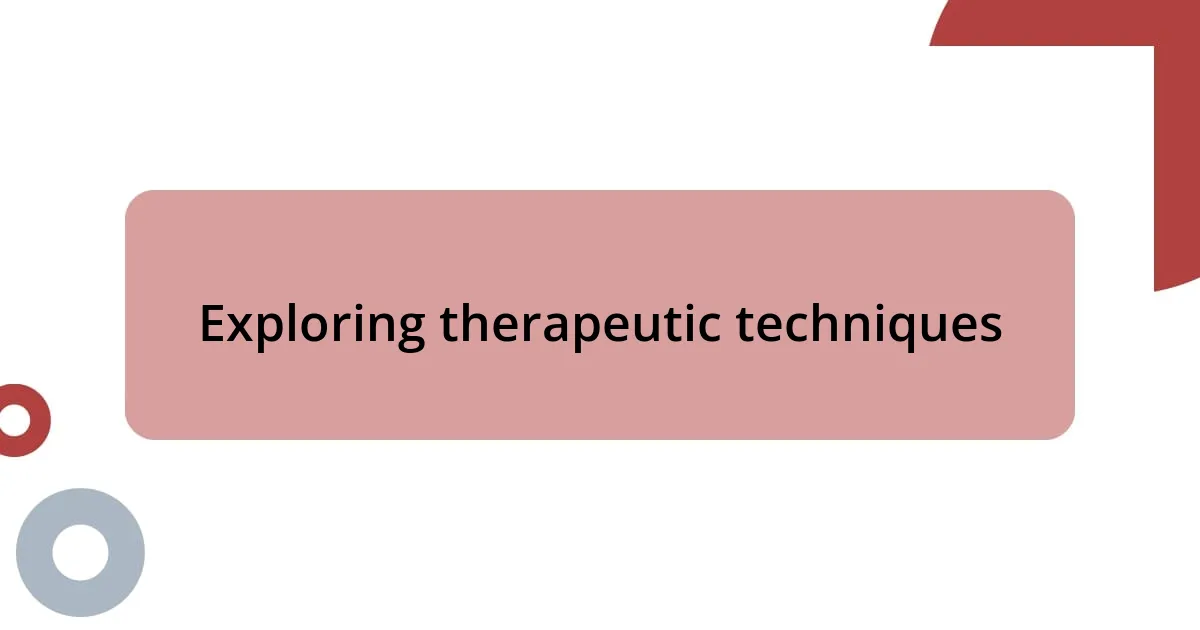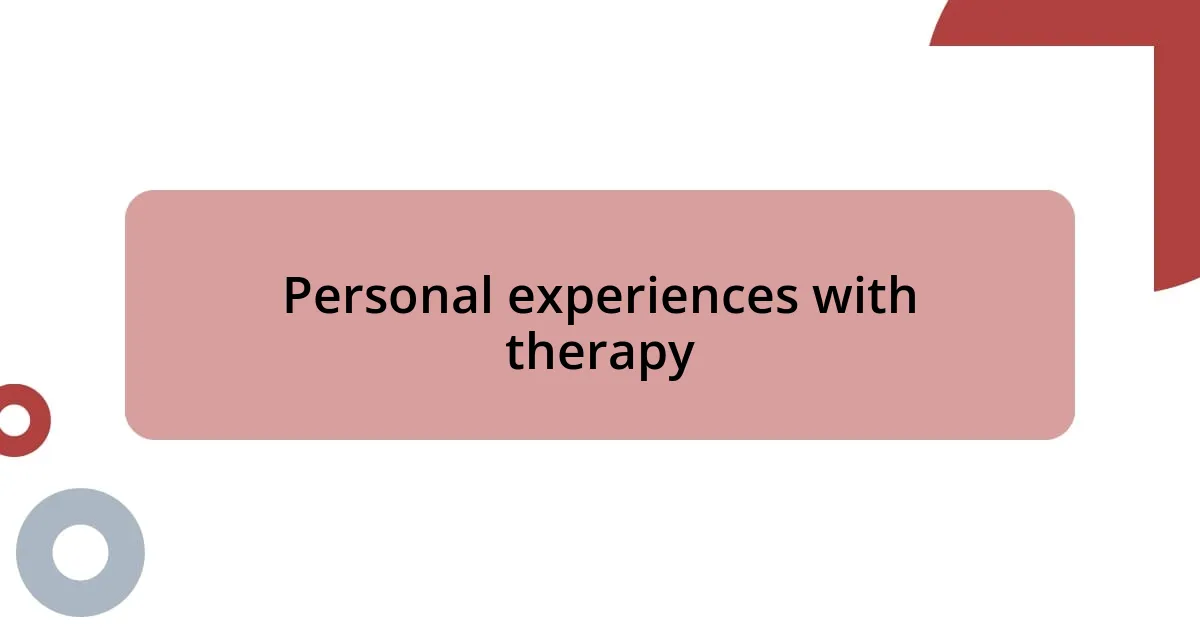Key takeaways:
- Therapy is a collaborative process that fosters personal growth through self-exploration and emotional expression.
- Mental health serves as a foundation for overall well-being, influencing energy levels, relationships, and resilience.
- Different types of therapy (e.g., CBT, DBT, art therapy) cater to diverse needs, highlighting that healing methods can vary significantly among individuals.
- The healing journey involves vulnerability, intention-setting, and the power of storytelling in reshaping personal narratives and fostering deeper connections.

Understanding therapy and healing
Therapy and healing are often intertwined journeys, each serving to address the complexities of our mental and emotional well-being. I remember my first experience with therapy; it felt like stepping into a warm space where my thoughts and feelings could breathe for the first time. Have you ever felt the burden of unexpressed emotions, like a balloon waiting to pop? That’s the essence of what therapy can unlock—creating a safe environment for exploration and understanding.
As I navigated my therapeutic journey, I discovered the importance of active healing. It wasn’t just about talking but also about actively engaging with my emotions and experiences. Sometimes, I would walk out of a session feeling lighter, almost as if I had shed a heavy coat that I didn’t realize I had been wearing. Healing requires us to face uncomfortable truths; isn’t that where the real transformation happens?
Understanding therapy means embracing it as a collaborative process. It’s not just about the therapist guiding you; it’s about building a partnership where your voice matters. I often think about how every story shared in those sessions adds another layer to my understanding of myself. Have you noticed that awareness can be the first step toward profound healing? It’s that realization that deep, personal insights pave the way for change.

Importance of mental health
Mental health isn’t just a buzzword; it’s a crucial pillar of our overall well-being. I’ve found that when my mental health is prioritized, everything else in my life tends to fall into place. Think about it: when you feel good mentally, your energy shifts, your outlook brightens, and you’re more resilient in facing life’s challenges. It’s like the difference between cloudy days and a clear blue sky—you can truly feel the impact on your mood and motivation.
One unforgettable moment for me was when I realized that neglecting my mental health was like allowing weeds to grow unchecked in a garden. I had pushed aside my anxieties and stress for so long that the tangled mess was choking out any positivity. Learning to cultivate that mental space was liberating; it allowed me to openly express my feelings and seek the support I needed. In essence, mental health is a garden that requires regular tending—allowing growth and harmony to flourish.
Moreover, mental health plays a pivotal role in our relationships and productivity. Whenever I put time and effort into nurturing my mental well-being, I find myself engaging more meaningfully with friends and family. It’s as if the emotional fog has lifted, making way for deeper connections. After all, when was the last time you felt energized and connected? That’s the magic that good mental health can bring into your life.
| Mental Health Aspect | Impact |
|---|---|
| Prioritizing mental health | Improved energy and resilience |
| Neglecting mental health | Weeds of anxiety and stress |

Different types of therapy
When it comes to therapy, I’ve come to appreciate the variety of approaches available. Each type caters to different needs and preferences, offering unique pathways to healing. For instance, I vividly remember trying cognitive-behavioral therapy (CBT) for the first time. It was eye-opening to realize how my thoughts shaped my feelings and behaviors. I found that by addressing distorted thought patterns, I could significantly alter my emotional responses.
Here’s a quick overview of some prominent types of therapy:
- Cognitive-Behavioral Therapy (CBT): Focuses on changing negative thought patterns.
- Dialectical Behavior Therapy (DBT): Combines CBT with mindfulness techniques, great for managing emotions.
- Humanistic Therapy: Emphasizes personal growth and self-actualization by exploring feelings.
- Psychodynamic Therapy: Delves into unconscious processes to uncover the influence of the past on present behavior.
- Art Therapy: Uses creative expression to help process emotions and experiences.
Each of these therapies has its own flavor, and it’s fascinating to see how they resonate differently with people. I still recall a friend who found solace in art therapy, using painting as a means to express feelings she couldn’t articulate. It reminded me that healing can be as diverse as our experiences, and what works for one person might open up a new world for another. Embracing this diversity can make a significant difference in one’s journey to mental well-being.

Exploring therapeutic techniques
Exploring therapeutic techniques can feel a bit like opening a treasure chest filled with tools that enhance our healing journey. For example, I once tried mindfulness-based therapy, which taught me to sit with my thoughts without judgment. This experience brought a profound sense of clarity; it was as if I began to see my emotional landscape more clearly, navigating through it with greater ease.
I often think about how sometimes it’s the simple techniques that pack the most punch. Take journaling, for instance. When I first started writing down my thoughts, I was amazed at how it allowed me to release pent-up emotions, almost like a pressure valve releasing steam. What have you found to be your own emotional outlet? It’s fascinating how one method can resonate with an individual while someone else may find their refuge in something entirely different, such as group therapy, where shared experiences create bonds of understanding.
Another therapeutic approach close to my heart is expressive arts therapy. I remember joining a workshop where we could use music, movement, or visual arts as our expressions of feelings. The freedom to create without the constraints of “perfection” opened up something within me. I left feeling unburdened, as if a weight had lifted. It truly highlighted how different techniques can unlock unique paths to healing. How do you like to express yourself? Each technique drives home the idea that therapy isn’t a one-size-fits-all; it’s a vibrant tapestry of experiences woven together to foster growth.

Personal experiences with therapy
Therapy has been a transformative experience for me, often challenging yet deeply rewarding. I remember one particular session where my therapist encouraged me to confront a long-held fear. I was nervous but went ahead, and to my surprise, I felt a wave of relief afterward. It was as though I had lifted a heavy weight off my chest, illuminating the notion that facing uncomfortable truths can pave the way to healing.
I also had a moment during group therapy that stands out in my memory. As I listened to others share their struggles, I felt an overwhelming sense of connection. It struck me how sharing our vulnerabilities can create a powerful bond. It became clear to me that being part of a community during therapy not only fosters understanding but also reminds us that we are not alone in our journeys. Have you ever felt that sense of belonging through shared experiences? I believe it enriches the healing process immensely.
Lastly, I can’t help but reflect on my experience with narrative therapy, where I learned to reframe my life story. Initially, it sounded a bit abstract, but once I started writing down my experiences, something magical happened. I realized that I could rewrite parts of my narrative and shift my perspective. It taught me the incredible power of storytelling in understanding and reimagining our struggles. Have you ever considered how the stories we tell ourselves shape our reality? The insights I gained from therapy continue to guide me as I navigate life’s ups and downs.

The healing process in therapy
The healing process in therapy often feels like peeling back layers of an onion. I recall a time when I engaged in cognitive behavioral therapy (CBT) and was encouraged to identify irrational thoughts. At first, it felt uncomfortable to really scrutinize my beliefs, but each session gradually revealed a clearer, more authentic version of myself. Have you ever faced the discomfort of delving deep into your thoughts? That vulnerability opened the door to significant change.
As I navigated through the healing journey, something else caught my attention: the role of vulnerability in therapy. There was a moment during a session when I shared a memory that I had tucked away for years. The weight of that revelation felt both freeing and terrifying, almost like stepping into a bright light after being surrounded by shadows. I realized that each time I allowed myself to be vulnerable, I was chipping away at my emotional walls. How do you approach vulnerability in your own life? Embracing it can lead to profound insights and deeper healing.
Another aspect of the healing process that resonated with me was the importance of setting intentions in therapy. I remember vividly a session where I expressed a desire to cultivate self-compassion. This commitment shifted the way I approached my struggles. Rather than dwelling on my mistakes, I found myself offering kindness and understanding, as if I were my own best friend. Have you ever set an intention that shifted your perspective? This simple act of intention setting created a ripple effect, enhancing my overall well-being and reinforcing the notion that healing is not just a destination, but a continuous journey.














